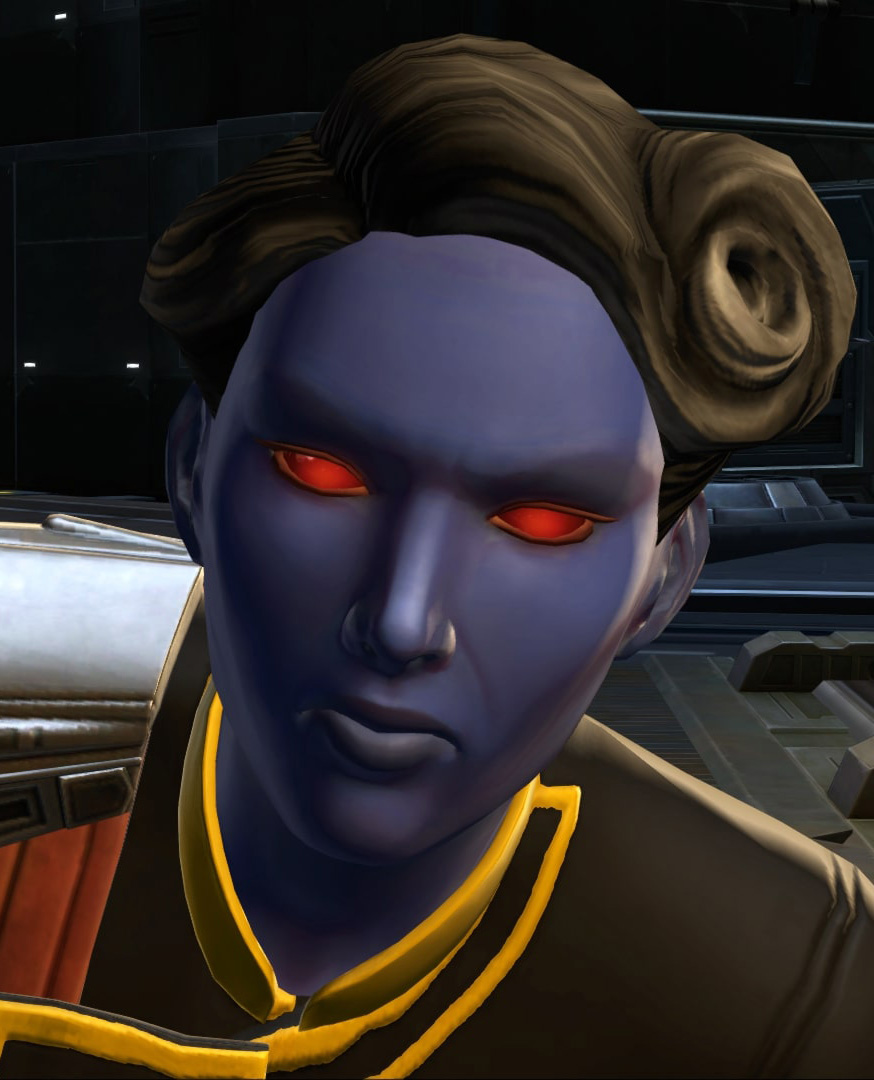The Ruling Families, or the Ruling Houses, also known as the Nine Ruling Families, the Nine Families, the Four Families, and at various points there were as many as twelve and as few as three Ruling Families, were a group of Chiss families that governed the Chiss Ascendancy. Their representatives composed the Council of Families. Each of the Ruling Families were associated with a specific color worn on the shoulder patches of the Defense Fleet uniforms of their officers and warriors.
In social and constitutional terms, the Ruling Families were an oligarchy which operated above the level of the professional bureaucracy and the (at least partially) democratic legislature. Each Family was responsible for a certain sector of Chiss government, and each had formal representatives with titles such as Aristocra and Syndic.
In order of least to greatest privilege within a Ruling Family, Chiss family ranks were:
- Merit adoptive
- Trial-born
- Ranking distant
- Cousin
- Sibling (brother or sister)
A family rank of shadow child also existed, which kept an individual with that rank completely secret, to prevent the complete extermination of a Ruling Family by their enemies.
While it seems that these titles often indicated literal blood relationships, they could also be awarded on merit, and while each Family was ultimately a kin-group, they also contained adoptive members who were not born into the oligarchy. For example, all Chiss warriors were classed as merit adoptives of a Ruling Family for the duration of their service in the Chiss Defense Fleet or Chiss Expansionary Fleet, while being named as Trial-born of a family enabled the most able commoners to aim for permanent "matching" to one of the Families—a process that seems to have involved marriage to an eligible member of the Family; in rare cases, a Trial-born matched to the Family might even secure the status of ranking distant.
Each Chiss Ruling Family had a fleet of warships used as planetary defense forces for a homeworld affiliated with that family referred to as Household Phalanxes. The most well-known one was a personal Household Phalanx of Syndic Mitth'raw'nuruodo.
According to the The University of Sanbra Guide to Intelligent Life made available through New Republic channels during the Yuuzhan Vong War, the Chiss Ruling Families traced their origins to the distant past, before the onset of the great ice age in which Csilla had been gripped throughout reliably-recorded Chiss history, and it was implied that every contemporary Chiss individual had a blood relationship with at least one of the Families. The same sources, however, made clear that the information available at this time about pre-glaciation Csilla took the form of contradictory legends, and it is not clear how reliable the claims for the antiquity of the Families could therefore be. Secondly, and especially bearing in mind the dubious nature of this first claim, the idea that all five trillion contemporary Chiss could then trace some form of biological descent to no more than nine pairs of historical ancestors must prima facie be treated with extreme caution.
Over the course of recorded history, the number of Ruling Families was said to have fluctuated between three and twelve, but in contacts with the Chiss in both 27 BBY and 22 ABY, it appeared that the number of Ruling Families stood nine, and they were known formally as the Nine Ruling Families. In 22 ABY, the issue on preemptive strikes along with their defensive-only doctrine became a subject of strenuous debate among the Nine Ruling Families. In the same year, Aide Chaf'ees'aklaio, core name "Feesa," of the Fifth Ruling Family explained to Dean Jinzler how the Nine Ruling Families were set up. Feesa described how the family ranks were structured and how they could be granted based on merits alone, or by blood.
Within a few years of the latter date, it was said that the number of Ruling Families had been reduced to four, identified as House Csapla, House Nuruodo, House Inrokini, and House Sabosen. This information seems to stem from the same New Republic sources mentioned above, which was confirmed by Jagged Fel shortly before the Jedi search for the sentient planet Zonama Sekot on Csilla in 28 ABY.

"Bronze" and "Rust," female Chiss representatives of the Four Families
During the search, a Jedi delegation led by Jedi Master Luke Skywalker met with the members of the Council of Families in the city of Ac'siel on Csilla, "Bronze," "Rust," "Gray" and "Copper-green" among them, who wore bronze, rust-red, silver-gray and copper-green head-to-foot robes that respectively reflected the colors of their Families. During their meeting, the representatives debated whether to permit the delegation to pass through the Chiss Space, with two members being open to the idea. Chief Navigator Peita Aabe, a representative from the Chiss Expansionary Defense Fleet, cast the deciding vote in favor of a compromise because the Council was unable to reach consensus. With unanimous approval from the Council, Aabe granted the delegation access to the Expeditionary Library for two days, while Gray presented them with Tris, a guide from the Inrokini family.
According to the account offered by Aristocra Chaf'orm'bintrano in 35 ABY, the Third Vagaari War had caused a serious labor shortage among the Chiss (whether through casualties or simply due to conscription), and they turned to the insectoid Killiks for help, and hired several Nests as workers. Steps were taken to prevent any Chiss becoming Joiners, but these were sabotaged, leading to the absorption of two Families into the Nests, while three others were unable to retain their position without the continued use of Killik labor.
Chaf'orm'bintrano claimed that this situation led to a "disagreement" in which the four other Families, assisted by Baron Fel and Syndic Mitth'raw'nuruodo's Household Phalanx, removed the three Killik-dependent lineages from power. A family of a syndic who opposed Fel's policies was destroyed by Soontir Fel during the conflict. However, there are some uncertainties about the nature of this account. Firstly, it seems unlikely that there really were three wars between the Chiss and the Vagaari; secondly, the Aristocra himself supposedly belonged to the Chaf family, one of the lineages not mentioned in the lists of the four surviving families; his remarks also suggested that Baron Fel's family had adopted at least some of the trappings of a Ruling Family in their own right.
By 41 ABY, the number of Ruling Families was once again nine. Though, which families returned to power was unknown.

Syndic Zenta of House Inrokini
At the time of the Yuuzhan Vong War and the Dark Nest Crisis, the Ruling Families included:
At the time of the Yuuzhan Vong War and the Dark Nest Crisis, former Ruling Families included:
The outlying colonies of Sharb, Noris, Schesa, Ornfra, Catlia and Massoss, homes to former Ruling Families, were largely wiped out prior to the Swarm War. Two of the Families who resided on the planets Catlia and Massoss respectively became Joiners in the Colony, while the others fell on a losing side of a civil conflict.
- "The University of Sanbra Guide to Intelligent Life: The Chiss" — Star Wars Gamer 5
- Alien Anthology
- The New Essential Guide to Characters
- Ultimate Alien Anthology
- The Official Star Wars Fact File137
- The Force Unleashed Campaign Guide
- The Complete Star Wars Encyclopedia
- The Essential Atlas
- The Unknown Regions
- The Essential Guide to Warfare